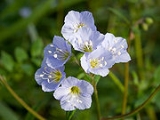
Polemonium reptans
Encyclopedia
Polemonium reptans is a flowering plant
in the genus Polemonium
, native to eastern North America. Common names include Abscess Root, Creeping or Spreading Jacob's Ladder, False Jacob's Ladder, American Greek Valerian, Blue bells, Stairway to Heaven, and Sweatroot.
herbaceous
plant growing to 50 cm tall, with pinnate leaves
up to 20 cm long with 5–13 leaflets. The flower
s are blue to violet, 1.3 cm long, with a five-lobed corolla.
Flowering plant
The flowering plants , also known as Angiospermae or Magnoliophyta, are the most diverse group of land plants. Angiosperms are seed-producing plants like the gymnosperms and can be distinguished from the gymnosperms by a series of synapomorphies...
in the genus Polemonium
Polemonium
Polemonium, commonly called Jacob's ladder, is a genus of about 30 species of flowering plants in the family Polemoniaceae, native to cool temperate to arctic regions of the Northern Hemisphere and also in the southern Andes in South America...
, native to eastern North America. Common names include Abscess Root, Creeping or Spreading Jacob's Ladder, False Jacob's Ladder, American Greek Valerian, Blue bells, Stairway to Heaven, and Sweatroot.
Growth
It is a perennialPerennial plant
A perennial plant or simply perennial is a plant that lives for more than two years. The term is often used to differentiate a plant from shorter lived annuals and biennials. The term is sometimes misused by commercial gardeners or horticulturalists to describe only herbaceous perennials...
herbaceous
Herbaceous
A herbaceous plant is a plant that has leaves and stems that die down at the end of the growing season to the soil level. They have no persistent woody stem above ground...
plant growing to 50 cm tall, with pinnate leaves
Leaf
A leaf is an organ of a vascular plant, as defined in botanical terms, and in particular in plant morphology. Foliage is a mass noun that refers to leaves as a feature of plants....
up to 20 cm long with 5–13 leaflets. The flower
Flower
A flower, sometimes known as a bloom or blossom, is the reproductive structure found in flowering plants . The biological function of a flower is to effect reproduction, usually by providing a mechanism for the union of sperm with eggs...
s are blue to violet, 1.3 cm long, with a five-lobed corolla.

